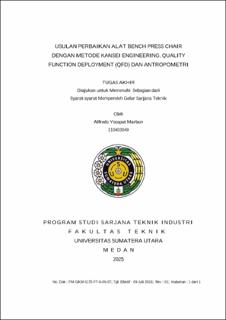Usulan Perbaikan Alat Bench Press Chair dengan Metode Kansei Engineering, Quality Function Deployment (QFD) dan Antropometri
Proposed Improvement of Bench Press Chair Tool with Kansei Engineering Method, Quality Function Deployment (QFD) and Anthropometry

Date
2025Author
Marbun, Alfredo Yosapat
Advisor(s)
Siregar, Khawarita
Metadata
Show full item recordAbstract
The sports industry is currently experiencing significant growth and will continue to grow rapidly in the future. The need for sports aids such as bench press chairs is increasingly important along with the increase in healthy lifestyles among the community. However, the results of observations show that the current bench press chair design still has several weaknesses such as the chair surface feels hard and uncomfortable, the width of the chair does not match the user's body, the chair material is easily slippery when sweating, the chair feels too hot after use, the chair sways or is unstable when used with heavy loads, and the chair height cannot be adjusted. This condition can reduce the comfort and safety of the user during training. This study aims to identify bench press chairs through an integrated approach of Kansei Engineering, Quality Function Deployment (QFD), and anthropometry, in order to analyze and evaluate the existing design so that improvement recommendations can be proposed in accordance with user needs. This study uses the Kansei Engineering method to identify users' emotional perceptions of bench press chairs through Kansei words, namely sturdy, comfortable, aesthetic, stable and modern. The Phase I Quality Function Deployment (QFD) method is used to translate user needs into technical characteristics, and continues with QFD Phase II to determine critical parts that need improvement. Based on the analysis of the House of Quality (HoQ) Phase I, the technical characteristics that are the main focus of the repair are the suitability of the dimensions of the tool. The results of the House of Quality Phase II show that the critical part that has the highest degree of importance is the dimension. Therefore, the suitability of the size is important to make improvements because it affects the user's comfort in using the bench press chair. Meanwhile, anthropometric methods were used to determine the optimal dimensions of the tool based on data on popliteal length, popliteal height, hip width, shoulder width in a sitting position, head length and head width resulting in a new design of bench press chair. The results of the proposal show that there is a change in the dimensions of the bench press chair from 119.0 cm long and 23.5 cm wide to 135.5 cm for length and 39.42 cm for width, to better suit user needs.
Collections
- Undergraduate Theses [1597]
